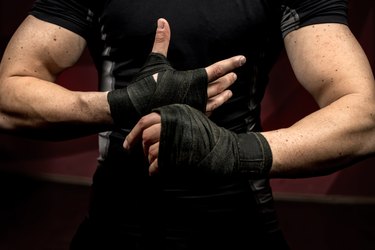
Boxing is one of the most demanding sports and also one of the most dangerous at the Olympics. A boxer needs to be strong, fast, smart and have the endurance to fight fatigue. If they get tired in the ring it's game over.
The skill of boxing takes countless hours to learn but that's not the only aspect of training. Fighters have to be fit enough to use the skills they learned through all three of the 3-minute rounds.
Video of the Day
Video of the Day
In the Olympics, boxing is very different from what it is at the professional level. This sets it apart from many other sports, where the Olympics are the biggest competition that someone can enter. Boxers use the Olympics more as a stepping stone between their amateur and professional career.
Basics of Boxing Training
There are only three 3-minute rounds in Olympic boxing, which is the typical length of an amateur boxing match. The focus is more on the technical aspect of boxing and scoring points than trying to knock an opponent out. With only three rounds of action, there is a sense of urgency to these matches that professional bouts don't have.
Since there are 3 minutes of fighting and 1 minute of rest between each round, Olympic boxers train using that time interval for as many exercises as they can. Many conditioning drills and boxing drills are structured with 3 minutes of work and 1 minute of rest.
Boxing Training
To get better, fighters use different boxing equipment in the gym and practice mock fights, called "sparring." Heavy bags are used to develop punching power and endurance. THye use speed bags and double-end bags to increase hand speed and reaction time. Skills developed on the uppercut bag build up a powerful uppercut, while boxers use the teardrop bag to practice hooks and uppercuts.
Boxers also practice fight scenarios with punching mitts and sparring. A coach will typically hold punching mitts and coach boxers through different punches and defensive techniques. They'll practice single punches and combinations, which is a series of punches and defensive maneuvers strung together.
Sparring is practice against an opponent while wearing full protective gear. Usually, a coach is present to encourage the fighters to work on technique and boxing strategy.

Conditioning
There is a mix of different theories on the best way to condition for a boxing match. On one hand, a boxer needs to exert themselves for 3 minutes and then take a 1-minute break to recover before working again. Therefore, the most sports-specific way to train is to do an activity like sprinting or swimming for 3 minutes at a high intensity, then rest and repeat.
On the other hand, fighters need to develop the endurance to box through three rounds. One of the best ways to build up endurance is to practice long-distance running or swimming.
Some boxing coaches incorporate both types of conditioning into their athlete's training. US Olympic boxer Mikaela Mayer does long-distance running three times per week and practices 400-meter sprints around a track three mornings per week. That gives her a balance between short-burst conditioning and long-term endurance.
British boxer Josh Kelly sprints for 3 minutes around a track and then rests for 1 minute. Some boxers have altogether abandoned long-distance running, however, since the repeated pounding can put them at risk for a leg injury.
Strength Training
Read More: Lifting After Boxing
A boxer doesn't need to be incredibly strong in order to fight well. They do, however, need to be fast. In the off-season, Olympic boxers will train with weights to get stronger and more muscular. They typically do exercises like squats, deadlifts, and bench presses because they're traditional strengthening movements.
As the Olympics approach, the fighters will switch to very fast exercises using light weight. Things like clap push-ups and squat jumps help build explosiveness. If they strength train for too long it can make them slower and more bulky, which is the worst thing for a boxer.
Weight
Boxing is a weight-class sport, meaning each fighter needs to be as lean as possible going into the Olympics. They sign up for a specific weight class and if they aren't at their weight on the day of the fight will be disqualified. That's why an athlete's weight is an extremely important part of training.
A proper diet and plenty of conditioning should keep a fighter around their target weight class. Weightlifting, however, can make them slightly bigger. That's why conditioning and boxing training take precedence over weightlifting in boxing. Weight lifting can cause a fighter to gain muscle, which is dense and heavy.
Read More: Boxer's Workout and Diet